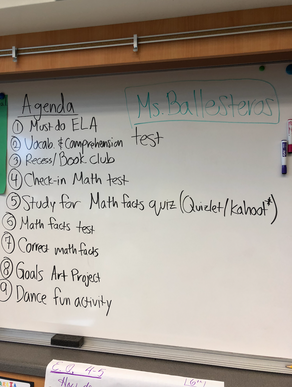
Name
M.A. Curriculum and Instruction '19
Preliminary Multiple Subject Teaching Credential '19
B.A. Integrated Educational Studies '18
Chapman University

Classroom Management & Social-Emotional Learning
My classroom management philosophy centers around a positive student-centered classroom environment, with a focus on social emotional learning. The physical environment itself uses natural lighting, has natural colors, is organized for efficiency, and has students seated in groups to facilitate collaboration. My class has a "Cool Down Corner" where students can go when they need to take a quick 3 minute break or need to self-regulate. I use Class Dojo as my PBIS class management system and parent communication medium. Each Dojo point equates to class money. Table groups of 5-6 students make teams where they can earn points as a group which also equates to class money. Students have class jobs and earn Class Dojo points for completing their jobs. Students needing extra behavioral support have token charts on their desks. They have a goal they are working toward and receive an initial from me when they are caught working on their goal. When they have filled up their token chart, students receive a prize they have filled up the token chart. Students also help create a class constitution of rules and expectations for behaviors to promote a community environment
The classroom culture will be one of constant communication and collaboration between teacher, student, parents, and school staff where the teacher serves as a facilitator of learning. The teacher will guide students in inquiry-based learning. Class content is also be relevant and value the diversity of students’ in the classroom by providing an opportunity to engage background knowledge and learn about others. The content will also address current world events to stay current in the world around them. Overall, my teaching philosophy will be student-centered with consistency in instruction, behavior management, and a positive classroom culture.
3rd & 4th Grade Classrooms



Student Teaching Examples
These images depict classroom management strategies that both my master teacher and I implemented in the 5/6 combo class. This school is part of an AVID district, so many of the classroom strategies are AVID. Examples include the Must Do/May Do lists to differentiate pacing of assignments for both grade and ability levels. Another AVID strategy depicted in the images include seating students in groups and giving points for positive behavior. Another example is the SLANT chart. Students are consistently reminded to follow SLANT to be an active listener and participant. The class and group rules are also depicted above. I liked her strategy of few and enforceable rules. These are examples of my master teacher's classroom management strategies that I took with me to my own classroom. One classroom strategy I used while substituting for my master teacher was putting a daily schedule on the board. This was helpful in keeping students on task and aware of what they were going to do when their teacher wasn't there.










